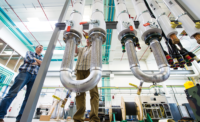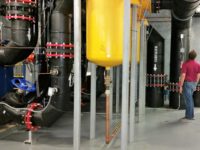According to the U.S. Department of Energy, roughly 430 quintillion Joules of the Sun’s energy reaches the Earth each hour. The Sun’s raw energy can be absorbed in two ways: Either the conversion of sunlight into electricity or the utilization of the sun’s energy as a direct source of heat. The latter has been in use since 1891 and has recently become mainstream again due to various incentives and pressures to utilize renewable energy sources.
The solar industry now has to serve a seemingly insatiable demand. It was only natural this movement towards renewable energy would become prevalent in all hot water applications, including those such as heating pools. With various benefits including efficiency as well as simple design and installation, solar pool heating systems have become a more eco-conscious way for providing a means of human comfort. The Uniform Solar, Hydronics & Geothermal Code (USHGC) is a key component to properly installing such systems. The USHGC can be utilized for proper installation of solar pool heating systems as it lists provisions for materials, installation and prevention of corrosion and heat loss.
Solar pool heating systems primarily consist of a solar collector, a filter, a pump and a flow control valve. The solar collector acts as the device which pool water is circulated through and heated using the sun’s energy. Typically, unglazed collectors are installed for such use due to their simple design, which consists of a heavy-duty rubber or plastic treated with an ultraviolet inhibitor to extend the life of the collector. As a means to protect the solar collector from debris, Section 505.3 of the USHGC lists provisions for filters and their required location within the system. Furthermore, sizing of the pump, which is used to direct water to the solar collector, must also be completed using the manufacturer’s pump performance graphs.
Since these systems utilize a pump and operate with high flow rates, they are considered to be active low temperature systems. This allows for the installation of piping and fittings which are meant for low temperature applications, such as polyvinyl chloride (PVC). PVC is most commonly recommended for solar pool heating systems due to its ability to withstand swimming pool chemicals. Plastic piping is also desirable for its flexibility, relatively high temperature properties and resistance to freezing and corrosion. Table 408.1, as provided in the USHGC, lists applicable material standards for PVC piping, tubing and fittings, and has proven to be an excellent source of material standards for all types of solar thermal systems.
As previously stated, high flow rates are desirable for these systems, but flow rates which are excessively high must be avoided as they cause erosion of interior pipe and fitting surfaces. This can be avoided by installing appropriately sized piping based on pipe flow charts pertaining to flowrate and correlating pressure drops.
Also addressed within the USHGC is corrosion prevention of solar pool heating systems. Section 505.4 of the USHGC prohibits the use of glazed solar collectors made of copper, as this material may lead to excessive concentrations of copper ions within the pool water. This excessive concentration of copper causes the pool water to become acidic as it drops the pH of the water. This also commonly leads to the formation of colored precipitates along the pool wall. The acceptable pH range for pool water falls between 7.2 and 7.8, and this range, along with various other acceptable water chemistry parameters, can be found in Table 505.2 of USHGC. As an added measure, the provisions in the Uniform Swimming Pool, Spa and Hot Tub Code (USPSHTC) can also be considered as it includes provisions for maintaining water quality not only for bather safety but also safety of swimming pool system components.
Solar pool heating systems also experience a vast amount of energy loss due to evaporation of heated water. Evaporation rates are dependent upon a variety of factors such as air temperature, relative humidity, wind velocity and water agitation. In order to raise one pound of water 1° F, one Btu of energy is required, but losing one pound of water at 82° due to evaporation causes a loss of 1,047 Btu of energy from the pool. In addition to installing active type solar systems as depicted previously, passive methods may also be used to decrease the amount of heat lost to due evaporation and increase the efficiency of the overall system. Installing vapor retardant covers when the pool is not in use, can drastically improve the system’s ability to meet the desired pool water temperature.
With the increasing concern revolving around minimizing the use of energy sources that rely on fossil fuels, a movement has been started to harness and convert solar energy as an environmentally friendly alternative. The USHGC provides a means of utilizing this free and renewable energy, and through its use, public health and safety as well as proper installation of solar pool heating systems can be assured. Overall, the USHGC is an excellent source for solar pool heating system provisions as they address water quality, installation, material standards, corrosion prevention and other various aspects of such systems.



